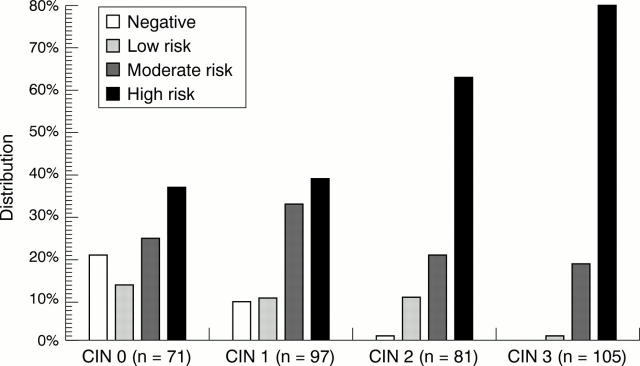Abstract
Aims—To determine whether the detection of high risk human papillomavirus (HPV) types is more predictive for high grade CIN than the current cervical smear test, and whether the production and measurement of HPV type 16 (HPV-16) and cellular survivin and telomerase transcripts can be used to discriminate between cervical HPV infections that self cure and those that induce high grade lesions.
Methods—Three hundred and fifty four cervical smear samples from women attending the colposcopy clinic were tested by the polymerase chain reaction (PCR) for the presence of HPV. Transcripts for HPV-16 E6, E6*I, E6*II, E7, and L1 as well as cellular survivin, telomerase RNA component, and telomerase reverse transcriptase were measured using fluorogenic probe (Taqman) assays.
Results—Referral smear grades of severe or moderate showed greater positive predictive values for CIN 2/3 than did the detection of high or moderate risk HPV types. HPV-16 transcripts from E6, E6*I, E6*II, and E7 showed high predictive values for CIN 2/3, but low sensitivity. The telomerase RNA component was detected in 53 of 57 samples and telomerase reverse transcriptase was only detected in one sample, whereas survivin transcripts were detected in 40% of samples.
Conclusions—The detection of HPV-16 or cellular survivin or telomerase transcripts did not accurately predict the grade of CIN in the samples. The detection of HPV risk types correlated well with the grade of CIN; however, the referral grade smear was the most accurate predictor of the severity of the lesion. Of the 35 different HPV types detected, 18 are not included in the HPV hybrid capture II commercial test kit. The use of such kits would have missed HPV infection in 4.3% of clinic patients with CIN 2/3 lesions and 15.4% with CIN 0/1.
Key Words: human papillomavirus type 16 • survivin • telomerase • CIN • transcripts • Taqman
Full Text
The Full Text of this article is available as a PDF (174.6 KB).
Figure 1 The distribution of human papillomavirus risk type with grade of CIN.
Selected References
These references are in PubMed. This may not be the complete list of references from this article.
- Ambrosini G., Adida C., Altieri D. C. A novel anti-apoptosis gene, survivin, expressed in cancer and lymphoma. Nat Med. 1997 Aug;3(8):917–921. doi: 10.1038/nm0897-917. [DOI] [PubMed] [Google Scholar]
- Ho G. Y., Bierman R., Beardsley L., Chang C. J., Burk R. D. Natural history of cervicovaginal papillomavirus infection in young women. N Engl J Med. 1998 Feb 12;338(7):423–428. doi: 10.1056/NEJM199802123380703. [DOI] [PubMed] [Google Scholar]
- Li F., Ambrosini G., Chu E. Y., Plescia J., Tognin S., Marchisio P. C., Altieri D. C. Control of apoptosis and mitotic spindle checkpoint by survivin. Nature. 1998 Dec 10;396(6711):580–584. doi: 10.1038/25141. [DOI] [PubMed] [Google Scholar]
- Takakura M., Kyo S., Kanaya T., Tanaka M., Inoue M. Expression of human telomerase subunits and correlation with telomerase activity in cervical cancer. Cancer Res. 1998 Apr 1;58(7):1558–1561. [PubMed] [Google Scholar]
- Tieben L. M., ter Schegget J., Minnaar R. P., Bouwes Bavinck J. N., Berkhout R. J., Vermeer B. J., Jebbink M. F., Smits H. L. Detection of cutaneous and genital HPV types in clinical samples by PCR using consensus primers. J Virol Methods. 1993 May;42(2-3):265–279. doi: 10.1016/0166-0934(93)90038-s. [DOI] [PubMed] [Google Scholar]
- de Roda Husman A. M., Walboomers J. M., van den Brule A. J., Meijer C. J., Snijders P. J. The use of general primers GP5 and GP6 elongated at their 3' ends with adjacent highly conserved sequences improves human papillomavirus detection by PCR. J Gen Virol. 1995 Apr;76(Pt 4):1057–1062. doi: 10.1099/0022-1317-76-4-1057. [DOI] [PubMed] [Google Scholar]



